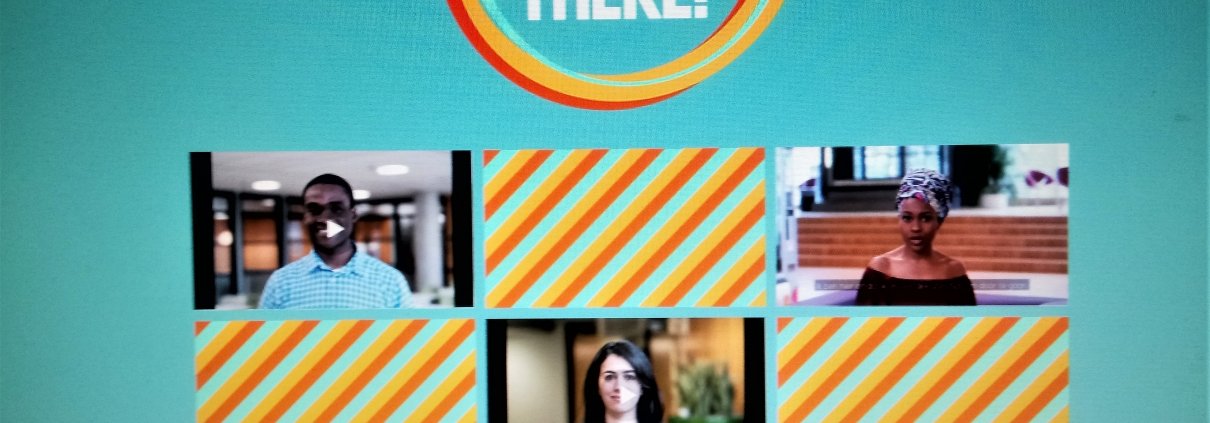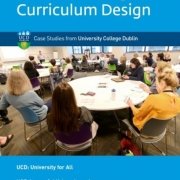Hang In There
Excerpt
Excerpt: The Hang In There project is one of the initiatives of the new lectorate Inclusive Education at The Hague University of Applied Sciences (THUAS). This initiative is similar to others like “The First (and last) 100 days initiative” and “The Inclusivity Toolkit” (both described elsewhere). Hang In There is led and initiated by the student branch of the lectorate, and intends to be accessible to all students who, for whatever reason, don’t feel quite at home at THUAS, experience loneliness, etc. One measure to increase accessibility is a recently launched website on which a variety of students candidly share their stories. At a certain point during their study years, these students were stuck and sometimes doubted the choices they had made. The site also contains a questionnaire; visiting students are warmly invited to anonymously tell (or share) their stories too. If they prefer, they will be contacted by peers to have a nice chat.
The lectorate wants these students, who usually seem to be overheard and overseen, to be noticed, to support them where they can and use their stories to raise awareness among the university community about (sometimes hidden) needs and feelings of their students.
Narrative, origins and objectives of the initiative
What kind of project is this? Please give a short description (summary) of it.
The Hang in There project is based on the work of Yeager and Walton from Stanford University and their research on growth mindset and belonging. They found that, for minority students, negative experiences and messages tend to have a greater impact on their level of confidence and belonging at an educational institution.
The Hang in There project consists of five parts. First, students are introduced to stories of other students who have struggled in their education. Second, they learn that difficulties can be overcome. Third, they are asked to answer some questions about their own struggles and vulnerabilities. Fourth, they are asked to write a story about overcoming difficulties themselves. Lastly, they learn that their contribution will be used to help and inspire others.
‘There’s got to be a part of them that is afraid (…), a part of them that wonders if they can make it. My bet is that the vast majority of them will make it. And they will, because nobody will give them the chance to simply give up.’ (Professor Laude of the University of Texas at Austin in New York Times, 2014; http://nyti.ms/1sQVz83).
Please tell us why, in general, this project is considered a successful one?
This is a new initiative, so it has yet to prove itself. It is expected to be successful because of its easy-accessible, low-cost “students for students” design. If the website reaches its target groups, the project can already be considered fruitful.
And why would you consider it a grass-roots initiative?
The initiative is led and initiated by students (student branch of the lectorate). On the website, students tell their stories and invite users to share theirs too. New students will join the project and support it.
What challenges needed to be solved in this project?
The main challenges are:
- To reach students that couldn’t be reached before: the ones who feel unsafe, lonely and/or not quite ‘at home’ at university, in their study programs due to various reasons but normally don't tend to look for help;
- To reach students who tend to drop out more often, postpone more, perform less etc.;
- To get an understanding of these students, their feelings, struggles and needs;
- To invite students to share their stories (if they want, anonymously), in order to help them to participate (again) and feel welcome and appreciated;
- To encourage students by convincing them that their own stories count, and that it can help others.
Is this initiative based on any particular theoretical framework? Which one?
This initiative is based on the work of Yeager, Walton and Cohen on growth mindset and social belonging. In the (American) context of their research, it was found that students' performances highly reflect their parents' income instead of their (potential) intelligence or abilities.
"(…). In one experiment after another, Yeager and Walton’s methods produced remarkable results. At an elite Northeastern college, Walton, along with another Stanford researcher named Geoffrey Cohen, conducted an experiment in which first-year students read brief essays by upperclassmen recalling their own experiences as freshmen. The upperclassmen conveyed in their own words a simple message about belonging: “When I got here, I thought I was the only one who felt left out. But then I found out that everyone feels that way at first, and everyone gets over it. I got over it, too.” After reading the essays, the students in the experiment then wrote their own essays and made videos for future students, echoing the same message. The whole intervention took no more than an hour. It had no apparent effect on the white students who took part in the experiment. But it had a transformative effect on the college careers of the African-American students in the study: Compared with a control group, the experiment tripled the percentage of black students who earned G.P.A.s in the top quarter of their class, and it cut in half the black-white achievement gap in G.P.A. It even had an impact on the students’ health — the black students who received the belonging message had significantly fewer doctor visits three years after the intervention." http://nyti.ms/1sQVz83
(Appendix) Is your intervention standing on its own or is it a part of a bigger and more holistic approach?
The Hang In There initiative is merely standing on its own, but can also be seen as part of a set of small-scale, affordable and accessible initiatives from the Lectorate Inclusive Education. Aligned initiatives are The First (and last) 100 Days Initiative and the Inclusivity Toolkit.
Please describe the group(s) intended as beneficiaries of this initiative
Why has this group (have these groups) been chosen?
The emphasis is on first year students; the initiative pays attention to reaching them early (preferably within the first 100 days). However, every student with a limited sense of belonging at THUAS can participate. It could be the case that some groups of students (first generation students, foreign students, students with psychological problems etc.), will be over-represented. If so, these are implicit target groups. One particular group to consider may be the Caribbean students (mainly from Dutch Antilles, due to The Netherlands’ colonial past): those coming from overseas, leaving behind their families, can experience culture shock (more individualism in Dutch culture), performance-related pressure (their ‘home fronts’, having high expectations of them) and could feel homesick (cold, wet climate and long, dark winter days, absence of family ties).
Could you please tell us something about the relative size of the (of each) target group, within the school/university population, region and/or country?
In general, no information is available about target groups because they are not explicitly defined (yet). In the Dutch context, students with secondary vocational diplomas, boys, so-called 1st generation students and students with migration backgrounds traditionally and consistently show higher dropout rates and perform poorer. These groups together represent a considerable part of the student population.
As for the potential target group of Caribbean students: In the municipality of The Hague, 8.7% (about 47.000 people) of grossly 540.000 city inhabitants have Surinam backgrounds, while 2,5% (almost 13.500 people) have Dutch Antilles backgrounds.[1] It is good to know, however, that many Antillean Caribbean students come straight from The Antilles to The Netherlands to study, not being part of the Antillean-Dutch community already living in the Hague (or The Netherlands). Annually, about 200 students from the Dutch Antilles islands arrive at THUAS.
[1] Source: demographic website of the Hague https://denhaag.buurtmonitor.nl/jive?cat_open_code=c923&lang=nl
Which social characteristics are taken into account and what is the geographical area covered?
Social characteristics taken into account are expected to correlate with (some of) the aforementioned circumstances: students combining two or more of these factors: secondary vocational backgrounds, male students, 1st generation students and those with migration backgrounds. For some, like Caribbean students, dedicated (language and culture) introductory programs are organized by THUAS. Geographical area is The Hague area.
On which level is the project implemented?
At THUAS level; it addresses all THUAS students.
Please describe the political and socio-economic factors that you believe have been important enablers for your initiative
Did the initiative have political support?
The Dutch government (Ministry of Education, Culture and Science) encourages more diversity in HE, and stimulates the universities (especially in the four biggest cities, the so-called Big Five of large professional HE organizations) to encourage emancipation and empowerment of underrepresented groups (with stipendiums, annual reports, etc.). In regional policies (e.g. Rotterdam The Hague metropolitan area), there is even more sense of urgency because the urban population here is super diverse. Educational organizations are stimulated to cooperate and to create pathways for students from underrepresented groups. The municipality of The Hague, for example, participates in projects to create a more inclusive local society and education.
How did it fit with local, regional or national policies?
The municipality of The Hague wants to pay extra attention to the different pathways to higher education and wants to encourage educational organizations to make their programs as accessible as possible.
Who are the stakeholders supporting the initiative?
First, the initiating students of the student branch of the lectorate Inclusive Excellence. Second, the lector and researchers of the lectorate. Third, teachers, coaches, managers, counselors and other university employees.
Are there particular demographic changes present that are influencing the project?
The Hague currently shows an (increasing) annual growth of over 6000 people (more than 1%), mostly caused by newcomers (like asylum seekers, refugees, EU- and non-EU work migrants, expats). Diversity of the city population is rapidly increasing, and this development is also mirrored in THUAS and its student population. Cultural differences should be addressed end discussed. THUAS wants to be a university that is open to everyone.
What is the institutional strategy and culture of the (educational) organization?
The Hague University of Applied Sciences (THUAS) wants to facilitate an inclusive, international and highly diverse university community. A community in which respect for different backgrounds and world views is a core value. In that way, its students are well prepared for the world of tomorrow, where a wide variety of talents can be identified and used for the benefit of all. THUAS wants to be ‘on top’ of these changes (slogan: “Let’s Change. You. Us. The world”).
To what extent does the initiative have an influence on institutional policy (or potential influence) of the (educational) organization?
In the end, the initiative aims, as already stated, to increase and widen awareness about the perspective, and needs, of possibly overheard students. The initiative is also intended to become part of a larger strategic and systemic approach in addressing the first 100 days at the university. The first 100 days are crucial for students’ success and endurance. It is the hope that Hang in There, in collaboration with other initiatives, will become part of standard policy. In that sense, the project wants to help operationalize the aforementioned strategy and desired working culture.
(Appendix) Is there public support for your initiative and the issue it addresses?
(Appendix) What other factors do you think have been important for the success of this initiative?
Has yet to be evaluated.
Please describe the overall initiative design and the methods and tools used to reach the goals
Please describe the specific activities carried out.
The Hang in There project has five videotaped stories by students who share their struggles with their education and how they have overcome them. The stories are placed on a specific “Hang in There” website. A student can choose to watch any selected number of the stories. Each story ends with the encouragement for the viewer to “hang in there”. Subsequent to the story there is a questionnaire where students are asked to list and describe their own struggles, vulnerabilities, wishes or needs. After the questionnaire (and, if applicable, being coached by their peers) students will be asked to write a letter of encouragement to the next cohort of students. Lastly, they are informed that their contribution will be used to help and inspire others.
What were the key roles (teacher, student, management team etc.) within the project?
Teachers are asked to encourage students to visit the Hang in There website. Teachers who also serve as student mentors are encouraged to use the Hang in There website as part of their counseling and guidance sessions. Students are the main participants. The student branch team has the primary responsibility to follow up on the students and collect the data. Students who leave their email address will receive follow up messages. As the project expands student organizations will be recruited to help follow up with students to provide messages of encouragement.
What ideas, tools, theories, models, methodology (etc.) have been used to reach the goals?
The methods and theories of Yeager, Walton and Cohen (2011, 2013), as initially described in an article in the New York Times (http://nyti.ms/1sQVz83), served as a reference model and inspiration for the development of the initiative, which was then implemented at THUAS in an adapted version.
Quote from the aforementioned article: "If you want to help low-income students succeed, it’s not enough to deal with their academic and financial obstacles. You also need to address their doubts and misconceptions and fears. To solve the problem of college completion, you first need to get inside the mind of a college student."
What are the final revenues of the project?
Please describe if your project ensured its sustainability
If so, how did you ensure the short-term impact of the project?
The design of the project makes it affordable and accessible. The website has been secured for at least two years and can easily continue. An asset is the students-for-students approach. Information about “silent” students can help the organization to improve its study environment. Implementing low-cost measures to improve education will keep the project warm.
And how did you ensure the long-term impact of the project?
It has not been ensured yet, but it would be a good thing if the project could be embedded in the organization and its mindset towards students.
Has your project been replicated elsewhere?
Please tell us about the resources used in this initiative
What was the budget for the initiative?
The only cost was the filming of the videos and securing a website and website domain. A student from the industrial design program was engaged to make the video’s and create the website, hence the costs were lower than if professional media services had been used. The total cost was about 1100 Euros.
How much did the initiative depend on volunteers?
Since the project is carried by the student branch of the lectorate and, therefore, can be considered a student-for-student initiative, it could easily generate volunteering students who feel addressed.
How were the costs perceived by the public/the sector/other stakeholders?
To what extent did the initiative achieve its objectives?
Please describe the evidence to support the success of your initiative.
Evidence / facts have to be produced yet. If the project is successful, target group students will be increasingly satisfied with their learning environment (including their teachers). They build better networks and show lower dropout rates than students from earlier cohorts. All students should feel acknowledged and have, therefore, a good sense of belonging at THUAS. Teachers will feel better equipped to deal with all students in their classroom and will look differently at their students’ behavior (and needs).
Did the intervention lead to any unintended (positive) outcomes?
Not yet, just started.
What indicators (quantitative and qualitative) have you measured to demonstrate success?
Indicators to be measured: self-report about the students’ self-esteem, sense of belonging and well-being in relation to their study environment (and program). Is it safe? Transparent? Stimulating? Furthermore, evaluation of the impact of the project (in terms of increased awareness in the wider university community) will also take place.



 Copyright by Mili Flener
Copyright by Mili Flener Interkulturelles Mentoring
Interkulturelles Mentoring


 (C)E-Fabrik • G.de CROP
(C)E-Fabrik • G.de CROP Simona Cerrato
Simona Cerrato